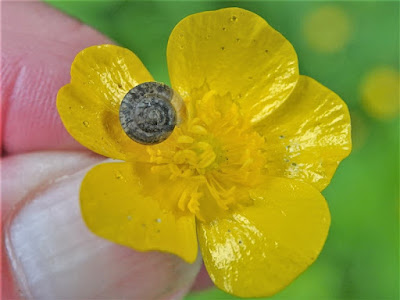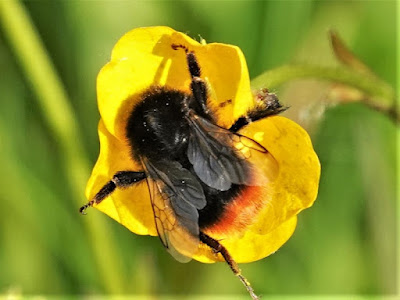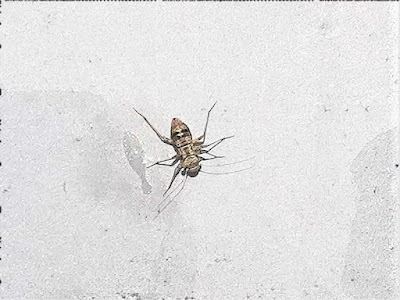Priorslee Lake and The Flash
10.0°C: Overcast. Moderate, chilly East wind. Very good visibility.
Sunrise: 04:54 BST
* = a photo of this species taken today
Very quiet in the dull and chilly conditions.
Priorslee Balancing Lake: 05:05 – 06:15 // 07:10 – 09:00
(114th visit of the year)
Bird notes:
- A second and perhaps a third Sedge Warbler have (re)appeared. On 6 May, my first visit after my US trip, I noted a record four singing birds. Three of these went quiet within three days and I assumed they had moved on. The remained bird sang at the West end. It was unusually secretive, never sitting on the vegetation and moving between the centre of small trees. Over the last few days the song has become much more intermittent. This morning there was one singing somewhat intermittently along the South side and another very vocal bird was singing and performing display flights in the scrub in the south-east area, behind the sailing club's platforms. Are these the original birds that stopped singing to raise their first brood and are now between broods? Or new arrivals, perhaps having failed to breed elsewhere? I am not sure whether I heard the bird at the West end very first thing. I did not later.
Birds noted flying over here:
- 4 Canada Geese: outbound together
- 2 Wood Pigeons only
- 1 Herring Gull
- 1 Lesser Black-backed Gull
- 1 Jackdaw
Warblers noted (the number singing in brackets):
- 1 (1) Cetti's Warbler
- 1 (1) Willow Warblers
- 13 (11) Chiffchaffs
- 2 (2) Sedge Warbler
- 9 (9) Reed Warblers
- 15 (12) Blackcaps
- 2 (1) Garden Warbler
- 1 (0) Common Whitethroat
Hirundines etc., noted:
- c.25 Swifts
- 8 Barn Swallows
- 4 House Martins
Counts from the lake area: it remains very quiet
- 2 + 2 (1 brood) Mute Swans
- 4 (4♂) Mallard: also a pair on a roof in Teece Drive
- no Moorhens
- 21 + 6 (3 broods) Coots
- 7 Great Crested Grebes
- 1 Lesser Black-backed Gull: briefly
- 1 Grey Heron: departed
+ = my first sighting of this species this year.
++ = new species for me.
On the street lamp poles at dawn:
Nothing noted
Noted later: chilly wind kept numbers low.
Butterflies:
- none
Moths:
- +Timothy Tortrix (Zelotherses paleana)
Bees / wasps etc.:
- Early Bumblebee (Bombus pratorum)
- Common Wasp (Paravespula vulgaris)
Dragon-/damsel-flies:
- none: too cold / windy
Hoverflies:
- none: too cold / windy
Other flies:
- *+two species of midge
- Black Snipefly (Chrysopilus cristatus)
- Yellow Dung Fly (Scathophaga stercoraria)
Beetles:
- Alder Leaf Beetle (Agelastica alni)
- *presumed Raspberry Beetle (Byturus tomentosus)
- *unidentified beetle sp.
Bugs:
- *Common Green Capsid (Lygocoris pabulinus)
- +* planthopper Eupteryx aurata
Also
- White-lipped Snail (Cepaea hortensis)
- +*tiny snail, possibly Wrinkled Snail (Xeroplexa intersecta)
- stretch spider Tetragnatha sp.
+Flowers first noted this year:
- *Spindle-tree (Euonymus europaea)
- *Common Bird's-foot Trefoil (Lotus corniculatus)
Another midge. I have not seen one with banded legs previously. Again unidentified.
I was checking the beetle on the left-most buttercup to confirm it was what I have been calling Raspberry Beetles (Byturus tomentosus). Only when I looked at the photo did I notice the smaller, unidentified beetle in the right-most buttercup.
Probably an Alder Leaf Beetle (Agelastica alni) though not on an Alder leaf. It is the right size and shape for this species.
This is a Common Green Capsid (Lygocoris pabulinus). It is indeed a very 'common' plant bug.
This tiny planthopper is Eupteryx aurata sometime called the Potato Planthopper though it is found on a wide range of plants including, as here, nettles (Urtica sp.).
Q: What is this lurking in a buttercup?
The inconspicuous flowers of the Spindle-tree (Euonymus europaea).
A flower I seem to have overlooked for several days is this Common Bird's-foot Trefoil (Lotus corniculatus).
(Ed Wilson)
------------------------------------------------------------------------------------------------------
The Flash: 06:20 – 07:05
(105th visit of the year)
Bird notes:
- *Now only five Mute Swan cygnets.
- I have no idea why the number of Tufted Duck is so variable. Certainly some day I can see birds sitting inside the island. Perhaps there are sometimes more out of sight?
- Some juvenile Coots are now venturing away from their nest sites and it is becoming more difficult to ascribe them all to their 'home brood'.
- Seven House Martins appeared together briefly. A food-pass was notes suggesting the first brood is on the wing and being fed.
Birds noted flying over here:
None
Warblers noted (the number singing in brackets):
- 5 (3) Chiffchaffs
- 4 (3) Blackcaps
Hirundines etc., noted:
- 7 House Martins
Noted on / around the water
- 32 Canada Geese
- 2 Greylag Geese
- *3 + 5 Mute Swans
- 22 (20♂) Mallard
- 1 (1♂) all-white duck (Peking(?) Duck)
- 5 (3♂) Tufted Duck
- 5 Moorhens
- 23+ 3 (? broods) Coots
- 3 Great Crested Grebes
- 1 Cormorant
On / around the street lamp poles:
Nothing noted
Noted elsewhere:
- Alder Leaf Beetles (Agelastica alni)
At The Flash the then five extant Mute Swan cygnets looking perky-enough.
Mr. House Sparrow looking very serious and intent on the business in hand.
(Ed Wilson)
------------------------------------------------------------------------------------------------------
On this day can be found via the yearly links in the right-hand column.
Sightings from previous years without links are below
2007
Wrekin
3 Tree Pipit
2 Wood Warbler
1 Pied Flycatcher
2 Spotted Flycatcher
(Martin Adlam)

































































